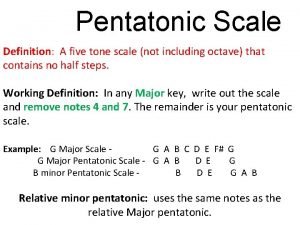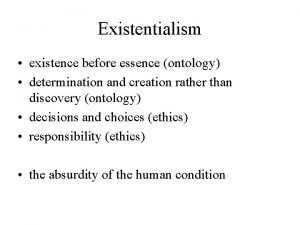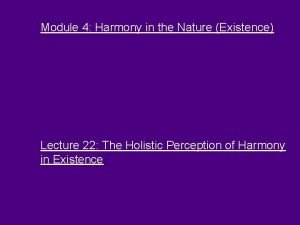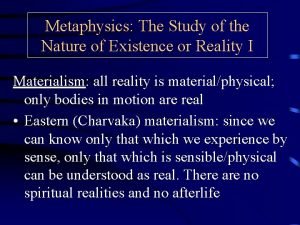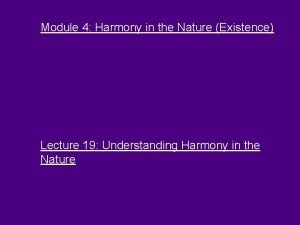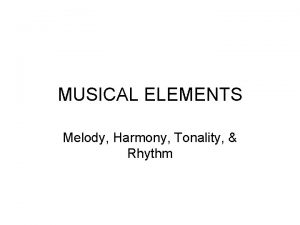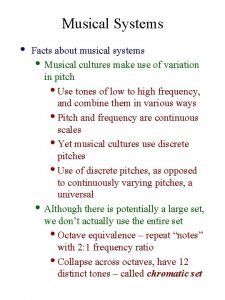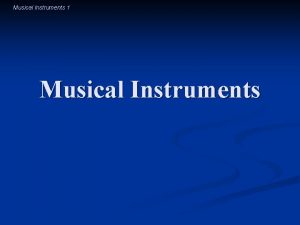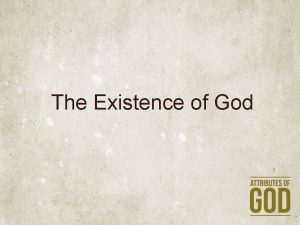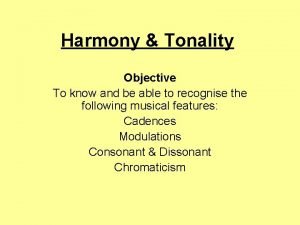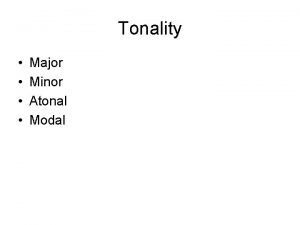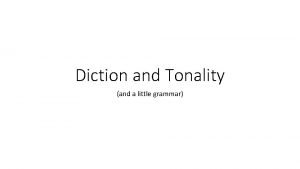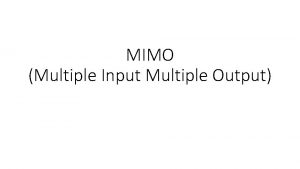Musical Tonality Existence of multiple tonalities raises a






























- Slides: 30

Musical Tonality • Existence of multiple tonalities raises a variety of questions • What is the relation of one tonality to another? • Can we measure relatedness? • How do we represent relatedness? • Questions regarding perception of tonality • How do we find our sense of key? • Are we accurate in sense of key? • What models do we have for determining key?

Theoretical Maps of Interkey Distances • Are there ways of deriving interkey distances? • Put differently, can we determine key maps? • Key distance an important issue in music-theoretic descriptions of tonal music because of key modulation • Musical composition written in home key • Compositions move to other keys, or modulate • Usually return to home key • Practice codified in interkey distances – key distances considered close if modulations are frequent

Interkey Distances The Circle of Fifths

Interkey Distances, con’t Diatonic set overlaps

Interkey Distances, con’t Diatonic set overlaps • The problem of minor keys • Different forms of the minor • Relation between the major and minor keys • The Relative Minor (C major and A minor) • Identical scale degrees • C Major: C D E F G A B • A Minor: A B C D E F G • The Parallel Minor (C major and C minor) • Common tonic and 5 th scale degree • C Major: C D E F G A B • C Minor: C D Eb F G Ab B

Interkey Distances, con’t Krumhansl & Kessler (1982)

Interkey Distances, con’t Interkey correlations

Interkey Distances, con’t Interkey correlations, graphed

Interkey Distances, con’t Krumhansl & Kessler (1982) Multidimensional scaling solution

Interkey Distances, con’t The four-dimensional torus

Interkey Distances, con’t Krumhansl & Kessler (1982) Map of key space

Interkey Distances, con’t Schoenberg (1954/1969) Chart of key distance

Interkey Distances, con’t Werts (1983) • Analyzed key progressions between compositions • Expressed as movement from one key to neighboring keys • Produced a multidimensional scaling solution based on number of times keys moved from one to another • Similar to MDS solution just seen

Models of Key Finding Longuet-Higgens & Steedman (1971) C Major Diatonic Scale: C D E F G A B Major Chords: C E G F A C G B D E C G C Major A E B F C G D C Minor B F C G D G# D# A F C B G D 0 Major 9 4 11 5 0 7 2 0 Minor 11 5 0 7 2 8 3

Models of Key Finding, con’t Longuet-Higgens & Steedman (1971) Map of key space A F C# E C G# B G D# F# D A# C# A F G# E C D# B G A# F# D F C# A C G# E G D# B D A# F# A F C# A F C # 9 5 1 4 0 8 11 7 3 6 2 10 1 9 5 8 4 0 3 11 7 10 6 2 5 1 9 0 8 4 7 3 11 2 10 6 9 5 1

Models of Key Finding, con’t Longuet-Higgens & Steedman (1971) Notes in Fugue Subject: E F# B C# D# E D# 4 6 11 1 3 4 3 C# D# E F# G# A# 1 3 4 6 8 9 E 4 B 11 F# G# A 6 8 9

Models of Key Finding, con’t Longuet-Higgens & Steedman (1971) Map of key space A F C# E C G# B G D# F# D A# Possible Keys: Note 1 (E) : C# A F G# E C D# B G A# F# D F C# A C G# E B, E, A, D, G, C, F# G D# B D A# F# A F C# A F C #

Models of Key Finding, con’t Longuet-Higgens & Steedman (1971) Map of key space A F C# E C G# B G D# F# D A# C# A F G# E C D# B G A# F# D F C# A C G# E Possible Keys: Note 1 (E) : B, E, A, D, G, C, F# Note 2 (E, F#) : B, E, A, D, G G D# B D A# F# A F C# A F C #

Models of Key Finding, con’t Longuet-Higgens & Steedman (1971) Map of key space A F C# E C G# B G D# F# D A# C# A F G# E C Possible Keys: Note 1 (E) : Note 2 (E, F#) : Note 3 (E, F#, B) : D# B G A# F# D F C# A C G# E G D# B B, E, A, D, G, C, F# B, E, A, D, G D A# F# A F C# A F C #

Models of Key Finding, con’t Longuet-Higgens & Steedman (1971) Map of key space A F C# E C G# B G D# F# D A# C# A F G# E C D# B G Possible Keys: Note 1 (E) : Note 2 (E, F#) : Note 3 (E, F#, B) : Note 4 (E, F#, B, C#) : A# F# D F C# A C G# E G D# B D A# F# B, E, A, D, G, C, F# B, E, A, D, G B, E, A A F C# A F C #

Models of Key Finding, con’t Longuet-Higgens & Steedman (1971) Map of key space A F C# E C G# B G D# F# D A# C# A F G# E C D# B G A# F# D Possible Keys: Note 1 (E) : Note 2 (E, F#) : Note 3 (E, F#, B) : Note 4 (E, F#, B, C#) : Note 5 (E, F#, B, C#, D#) : F C# A C G# E G D# B D A# F# A F C# A F C # B, E, A, D, G, C, F# B, E, A, D, G B, E, A B, E

Models of Key Finding, con’t Longuet-Higgens & Steedman (1971) Map of key space A F C# E C G# B G D# F# D A# C# A F G# E C D# B G A# F# D F C# A C G# E G D# B D A# F# A F C# A F C # Possible Keys: Note 1 (E) : B, E, A, D, G, C, F# Note 2 (E, F#) : B, E, A, D, G Note 3 (E, F#, B) : B, E, A, G Note 4 (E, F#, B, C#) : B, E, A Note 5 (E, F#, B, C#, D#) : B, E. . . Note 10 (E, F#, B, C#, D#, G#) : B, E Note 11 (E, F#, B, C#, D#, G#, A) : E

Models of Key Finding, con’t Longuet-Higgens & Steedman (1971) Notes in Fugue Subject: C Db C B E F Bb A Ab G 0 11 4 5 10 9 8 7 (0 1 4 5 7 8 9 10 11)

Models of Key Finding, con’t Krumhansl-Schmuckler Key-Finding Algorithm (Krumhansl & Schmuckler, 1986, Schmuckler & Tomovski, 1995) Schubert, Op. 94, no. 1 – Tone durations

Models of Key Finding, con’t Krumhansl-Schmuckler Key-Finding Algorithm (Krumhansl & Schmuckler, 1986) Bach, C Minor Prelude – Tone durations

Models of Key Finding, con’t Krumhansl-Schmuckler Key-Finding Algorithm (Schmuckler & Tomovski, 2005)

Models of Key Finding, con’t Krumhansl-Schmuckler Key-Finding Algorithm (Schmuckler & Tomovski, 2005)

Models of Key Finding, con’t Brown & Butler (1981) Intervals of the diatonic set Major Scale

Models of Key Finding, con’t Brown & Butler (1981) Trichords and the rare interval

Models of Key Finding, con’t Brown & Butler (1981) Intervals of the diatonic set Minor Scale
 Five-tone scale
Five-tone scale Tonality film
Tonality film Si patokaan elements of music
Si patokaan elements of music Breakdown of tonality
Breakdown of tonality Multiple intelligences musical
Multiple intelligences musical Melissa raises crickets
Melissa raises crickets Jesus raises the son of the widow of nain
Jesus raises the son of the widow of nain A rising tide raises all boats proverb
A rising tide raises all boats proverb Brutus a champion weightlifter raises
Brutus a champion weightlifter raises Delayed multiple baseline design
Delayed multiple baseline design Multiple instruction multiple data
Multiple instruction multiple data Optional and mandatory relationship in erd
Optional and mandatory relationship in erd Existence
Existence Existence before essence
Existence before essence Explanation experience existence exciting
Explanation experience existence exciting Universal human order
Universal human order What is existence
What is existence Existence and uniqueness theorem
Existence and uniqueness theorem Three marks of existence
Three marks of existence Existence precedes essence in french
Existence precedes essence in french účel (smysl) existence firmy určuje
účel (smysl) existence firmy určuje Eightfold path
Eightfold path Study of the nature of existence
Study of the nature of existence Existence
Existence Lesson 3 existence and uniqueness
Lesson 3 existence and uniqueness Harmony in the nature and existence
Harmony in the nature and existence What are the 3 marks of existence
What are the 3 marks of existence Individual existence
Individual existence The universal soul has been referred to as
The universal soul has been referred to as A habitat supplying the necessary factors for existence
A habitat supplying the necessary factors for existence Disembodied existence definition
Disembodied existence definition
